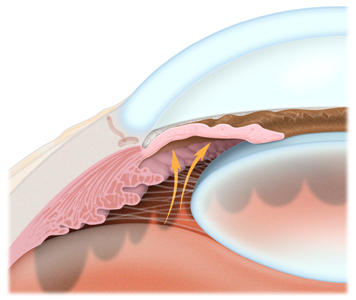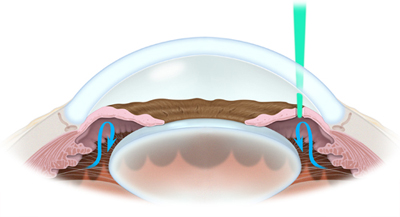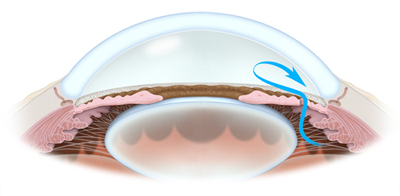Narrow-angle glaucoma suspect
“Narrow” or “closed” angles means that the drainage channel of your eye is blocked or nearly blocked, placing you at high risk for elevated intraocular pressure and vision loss: angle-closure glaucoma. Aqueous humour is produced in the ciliary body of the eye at the root of the iris, then flows around the front of the lens, into the anterior chamber, then out the angle through the trabecular meshwork.

Acute angle closure (relative pupillary block)
An acute attack of angle-closure glaucoma is marked by very high eye pressure and complete blockage of the drainage channel in the eye. Symptoms include pain, redness of the eye, and decreased vision. The most common mechanism for this is the so-called “relative pupillary block” whereby the fluid is not flowing through the pupil as fast as it is being produced so the peripheral iris gets pushed forward, blocking the angle.
Treatment of angle closure
To treat angle-closure glaucoma, your ophthalmologist will perform a laser peripheral iridotomy (LPI), creating an opening within the peripheral iris (the colored part of the eye) using a laser. This opening is typically so small that it cannot be seen without the aid of a magnification at the examining slit lamp biomicroscope. The opening in the iris allows fluid to flow from behind the iris through the opening, allowing the iris to return to a more normal position and open the drain.


Treatment will not improve your vision
This laser treatment is always performed on an outpatient basis, often in the ophthalmologist’s office. The treatment will not improve your vision, but it can help prevent vision loss from a dangerous type of glaucoma. The side effects of the treatment can include the appearance of a “light streak,” a temporary rise in intraocular pressure, and inflammation. Before the laser treatment, you may receive a drop of pilocarpine to constrict your pupil; this can cause a headache around your eyebrow. After the treatment, you will receive a prescription for an anti-inflammatory drop, such as prednisolone acetate, to use for a few days to help prevent inflammation. Follow-up visits will be arranged to check for inflammation, make sure the iridotomy is patent and that the angle has widened.
Cataract surgery for occludable angles
For some patients, your Ophthalmologist might recommend proceeding with cataract surgery to free up space in the front of the eye, opening the angle. This can be a better option than the laser peripheral iridotomy for some patients.
© 2025, 2015 Dr. Robert Schertzer Inc. based on 2007 The American Academy of Ophthalmology
